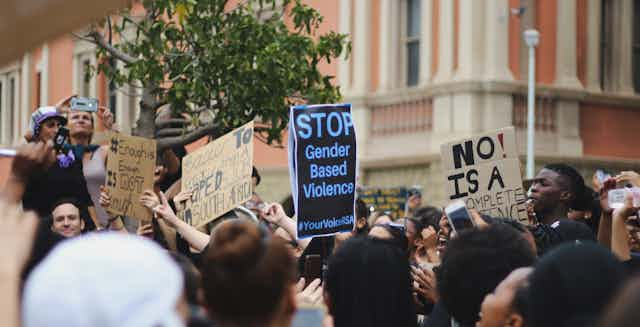Every November the United Nations marks a 16-day campaign against gender-based violence. It begins on Nov. 25, the International Day for the Elimination of Violence against Women, and ends on Dec. 10, Human Rights Day. This year’s theme is “UNiTE! Activism to end violence against women and girls.”
This theme aims to highlight the impact of COVID-19 on gender-based violence, as well as inequalities in accessible housing, services and resources.
During pandemic lockdowns women experiencing gender-based violence found themselves in precarious and dangerous circumstances. Many women facing violence had to contend with the prospect of homelessness as a result of limited housing options.
Gender-based violence and COVID-19
COVID-19 lockdowns exacerbated the pre-existing problem of gender-based violence. Families who were already dealing with violence were no longer able to leave the home for work, school or social activities. This left many women trapped with abusive partners which led to increased rates of violence against women.
Spaces like religious gatherings, workplaces, community centers, support groups and community agencies where women could get some reprieve and support were also no longer easily accessible.
The pandemic also highlighted a larger social divide and social inequalities in access to health care and housing, as well as poor working conditions. It had a more severe impact on lower-paid people — many of whom are women — who were often the first to lose their jobs. This led to women falling behind on rent and having to move in with family.

These divides do not come as a surprise to women and children fleeing violence. Research, and the experiences of those fighting gender-based violence, have illustrated that women face multifaceted challenges when accessing social services and supports.
Specifically, racialized women face unique vulnerabilities that increase their risk of violence and access to services. These include restrictive immigration laws and racial profiling. Exploring the relationship between COVID-19 and gender-based violence is key to understanding women’s experiences. Gender-based violence survivors’ experiences must be understood from an intersectional approach.
The housing crisis
Due to financial dependence and an increasingly unaffordable housing market, women and children fleeing violence are in dangerous positions. In many large cities, housing costs have been skyrocketing. The average monthly rent across Canada is more than $2,000 per month.
Many women face the difficult decision of staying with abusive partners or family members. A problem that many women struggling to support their children have voiced is having to choose between buying food and paying rent.
With housing increasingly unaffordable, women fleeing violence are struggling to find a secure place to live. This puts women at risk and places them back at the mercy of their abusers.
Across Canada, women are staying in shelters longer. In Nova Scotia for instance, there is limited funding for second stage housing which supports women transitioning from temporary shelters to permanent housing.

Survivors of abuse in Canada are given priority on social housing wait-lists based on a special priority criterion. This criterion includes leaving abusive relationships within 90 days and providing proof of cohabitation. But wait times for social housing are long and these criteria do not apply to everyone.
Consequently, many women remain in unhealthy and abusive households because they cannot afford to live elsewhere. Domestic violence shelters often turn away women and children due to lack of beds. Those that make it in shelters in Canada are having longer stays.
Many survivors live in risky, temporary housing, yet are considered safe because they no longer live with their abusers. Survivors choose temporary housing options to protect their children’s lives, stability and welfare, meet basic needs and avoid child welfare agencies. This tends to leave survivors homeless or at risk of returning to their abusers.
Survivors also face challenges applying for the help they need. The need for virtual meetings and application processes during the pandemic raised new challenges for social housing application access.
Due to limited access to the internet, computers, skill set gaps and use of shared devices, some survivors cannot safely and privately seek help and complete applications at home.
Exploring the intersections between systemic oppression and women’s vulnerabilities is critical. The 16 Days of Activism are a call for all levels of government to address the housing gap and gender-based violence.
Building more affordable housing, improving access to subsidized housing and increasing benefit assistance rates are some sustainable solutions to the chronic cycle of homelessness faced by women fleeing violence.

